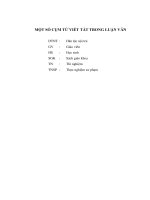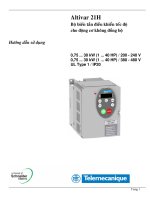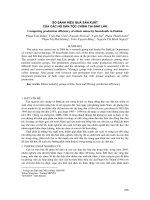10376 toc
Bạn đang xem bản rút gọn của tài liệu. Xem và tải ngay bản đầy đủ của tài liệu tại đây (422.51 KB, 12 trang )
Contents
About the Editors .............................................................
vi
Contributors .....................................................................
vii
Preface ............................................................................
ix
1. Introduction: an Overview of the Chemical
Process Industry and Primary Raw Materials .......
1
1.1
The Chemical Process Industry .................................
1
1.2
Development of the Chemical Industry ......................
2
1.3
Characteristics of the Chemical Industry ...................
3
1.4
Raw Materials, Manufacturing, and
Engineering ................................................................
5
Environmental Aspects ..............................................
8
References ............................................................................
9
2. Safety Considerations in Process Industries ........
11
1.5
2.1
Introduction .................................................................
12
2.2
OSHA (Occupational Safety and Health
Administration) and PSM (Process Safety
Management) .............................................................
14
2.3
Incident Statistics and Financial Aspects ..................
16
2.4
Safety Decision Hierarchy ..........................................
16
2.5
Hazard Analysis and Risk Assessment
(HARA) .......................................................................
17
Types of Hazards in Industries ..................................
18
2.6.1
18
2.6
Heat and Temperature .............................
This page has been reformatted by Knovel to provide easier navigation.
v
vi
Contents
2.6.2
Pressure Hazards .....................................
19
2.6.3
Electrical Hazards ....................................
21
2.6.4
Mechanical Hazards .................................
23
2.6.5
Toxic Materials .........................................
24
2.6.6
Fire and Explosion ...................................
27
2.6.7
Accelerator and Falling Objects ................
30
2.6.8
Confined Space ........................................
31
2.6.9
Radiation ..................................................
33
2.6.10 Noise and Vibrations ................................
37
2.6.11 Ergonomics ..............................................
39
Risk Management Plan ..............................................
40
2.7.1
The Role of Safety Personnel ...................
40
2.7.2
Personal Protective Equipment
(PPE) .......................................................
41
Appraising Plant Safety and
Practices ..................................................
44
Planning for Emergencies ........................
45
References ............................................................................
47
3. Industrial Pollution Prevention ...............................
49
2.7
2.7.3
2.7.4
3.1
Definition of Industrial Waste .....................................
50
3.2
Types of Industrial Wastes .........................................
51
3.2.1
Classification of Industrial Waste ..............
52
3.3
Public Concern over Pollution ....................................
54
3.4
Legislation to Waste Management ............................
56
3.5
Industrial Pollution Prevention ...................................
57
3.6
Assessment of Industrial Pollution Prevention ..........
58
3.6.1
Assessment of Waste Generation ............
58
3.6.2
Feasibility of the Industrial Pollution
Prevention ................................................
59
Feasibility Implementation ........................
59
3.6.3
This page has been reformatted by Knovel to provide easier navigation.
Contents
vii
Waste Management ...................................................
61
3.7.1
Procedural Change ..................................
61
3.7.2
Technology Change .................................
63
3.7.3
Input Material Change ..............................
64
3.7.4
Product Change .......................................
64
Recycling ....................................................................
64
3.8.1
Options in Recycling .................................
65
3.8.2
Recycling Technologies ...........................
66
Waste Treatment ........................................................
69
3.9.1
Physical Treatment ...................................
70
3.9.2
Chemical Treatment .................................
73
3.9.3
Biological Treatment .................................
75
3.10 Waste Disposal by Incineration .................................
77
3.10.1 Rotary Kiln Incinerators ............................
78
3.10.2 Liquid Injection Incinerators (LII) ..............
79
3.10.3 Fluidized Bed Incinerators ........................
81
3.10.4 Multiple-Hearth Incinerators .....................
81
3.11 Ultimate Disposal .......................................................
81
3.11.1 Land-Farming ...........................................
81
3.11.2 Landfilling .................................................
82
3.11.3 Deep-Well Injection ..................................
83
3.11.4 Ocean Dumping .......................................
83
References ............................................................................
84
4. Edible Oils, Fats, and Waxes ..................................
85
3.7
3.8
3.9
4.1
Introduction .................................................................
86
4.2
Fatty Acids ..................................................................
88
4.3
Glycerides ..................................................................
92
4.4
Physical Properties of Triglycerides ...........................
94
4.4.1
94
Melting Point ............................................
This page has been reformatted by Knovel to provide easier navigation.
viii
Contents
4.5
4.4.2
Specific Heat ............................................
94
4.4.3
Viscosity ...................................................
94
4.4.4
Density .....................................................
96
4.4.5
Refractive Index .......................................
96
4.4.6
Polymorphism ..........................................
96
4.4.7
Other Physical Properties .........................
96
Chemical Properties of Triglycerides .........................
98
4.5.1
Hydrolysis ................................................
98
4.5.2
Methanolysis ............................................
98
4.5.3
lnteresterification ......................................
98
4.5.4
Hydrogenation ..........................................
99
4.5.5
Isomerization ............................................ 100
4.5.6
Polymerization .......................................... 100
4.5.7
Autoxidation ............................................. 100
4.6
Sources of Edible Oils and Main Fats .......................
102
4.7
Oils and Fats: Processing and Refining ....................
103
4.8
Fats and Oils Stability and Antioxidants ....................
115
4.9
Methods of Analysis and Testing of Fats
and Oils ......................................................................
118
4.9.1
Identification and Compositional
Analysis .................................................... 118
4.9.2
Quality Control Tests ................................ 120
References ............................................................................
121
5. Soaps and Detergents ............................................. 123
5.1
Soap ...........................................................................
123
5.1.1
Introduction .............................................. 123
5.1.2
History ...................................................... 124
5.1.3
Raw Materials .......................................... 125
5.1.4
Chemistry of Soaps .................................. 125
5.1.5
Classification of Soaps ............................. 126
This page has been reformatted by Knovel to provide easier navigation.
Contents
5.2
5.3
5.4
ix
5.1.6
Manufacturing of Soaps ........................... 127
5.1.7
Environmental Aspects ............................. 130
Detergent ....................................................................
130
5.2.1
Introduction and History ........................... 130
5.2.2
Principle Groups of Synthetic
Detergents ............................................... 132
5.2.3
Surfactants ............................................... 133
5.2.4
Inorganic Builders .................................... 144
5.2.5
Sundry Organic Builders .......................... 149
5.2.6
Manufacturing of Detergents .................... 153
Environmental Aspects ..............................................
156
5.3.1
Emissions and Controls ............................ 156
5.3.2
Wastewater and the Environment ............. 157
5.3.3
Biodegradation ......................................... 158
Economic Aspects ......................................................
159
References ............................................................................
160
6. Sugar ......................................................................... 163
6.1
Introduction .................................................................
163
6.2
The Chemistry of Saccharides ...................................
164
6.3
Properties of Sucrose ................................................
167
6.4
Historical Survey and World Production ....................
168
6.5
Cane Sugar ................................................................
170
6.5.1
Raw Sugar Manufacture ........................... 170
6.5.2
Refining of Raw Sugar ............................. 180
6.6
Beet Sugar .................................................................
184
6.7
Other Sugars ..............................................................
189
6.8
By-Products of the Sugar Industry .............................
191
6.9
Other Sweeteners ......................................................
192
6.9.1
Acesulfame-K ........................................... 194
This page has been reformatted by Knovel to provide easier navigation.
x
Contents
6.9.2
Alitame ..................................................... 194
6.9.3
Aspartame ................................................ 195
6.9.4
Cyclamate ................................................ 195
6.9.5
Saccharin ................................................. 196
6.9.6
Sucralose ................................................. 197
6.10 Sugar Analysis ...........................................................
197
References ............................................................................
198
7. Paints, Pigments, and Industrial Coatings ............ 201
7.1
Introduction .................................................................
201
7.2
Constituents of Paints ................................................
204
7.2.1
Pigments .................................................. 204
7.2.2
Inorganic Pigments ................................... 209
7.2.3
Organic Pigments ..................................... 217
7.2.4
Binders ..................................................... 221
7.2.5
Solvents ................................................... 226
7.2.6
Additives .................................................. 227
7.3
Paint Formulation .......................................................
231
7.4
Paint Manufacture ......................................................
234
7.5
7.4.1
Pigment Dispersion .................................. 234
7.4.2
Processing Operations ............................. 237
7.4.3
Classification and Types of Paints ............ 238
7.4.4
Varnishes ................................................. 245
7.4.5
Lacquers .................................................. 245
Paint Application and Causes for Paint Failure .........
246
7.5.1
Techniques of Paint Application ............... 246
7.5.2
Causes for Paint Failure ........................... 248
7.6
Testing and Quality Control .......................................
254
7.7
Environmental Impacts and Risks .............................
255
References ............................................................................
256
This page has been reformatted by Knovel to provide easier navigation.
Contents
xi
8. Dyes: Chemistry and Applications ......................... 259
8.1
Introduction .................................................................
259
8.2
Colorants ....................................................................
260
8.3
Classification of Dyes .................................................
261
8.4
Textile Fibers ..............................................................
268
8.5
The Application of Dyes .............................................
272
8.6
Intermediates ..............................................................
274
8.6.1
Miscellaneous Reactions .......................... 285
8.7
Manufacture of Dyes ..................................................
286
8.8
Environmental and Health Aspects ...........................
287
References ............................................................................
288
9. Industrial Fermentation ........................................... 289
9.1
Introduction and History .............................................
290
9.2
Biochemical and Processing Aspects ........................
292
9.3
9.4
9.2.1
Overview .................................................. 292
9.2.2
Microorganisms ........................................ 293
9.2.3
Culture Development ................................ 296
9.2.4
Process Development .............................. 298
9.2.5
Bioreactors ............................................... 300
9.2.6
Downstream Processing ........................... 303
9.2.7
Animal and Plant Cell Cultures ................. 304
Food and Feed Treatment by Fermentation ..............
304
9.3.1
Food Conservation ................................... 304
9.3.2
Feed and Agriculture ................................ 309
9.3.3
Single Cell Protein (SCP) ......................... 309
Industrial Chemicals by Fermentation .......................
311
9.4.1
Ethanol ..................................................... 311
9.4.2
Other Industrial Alcohols .......................... 312
9.4.3
Organic Acids ........................................... 313
This page has been reformatted by Knovel to provide easier navigation.
xii
Contents
9.5
9.4.4
Amino Acids ............................................. 314
9.4.5
Vitamins ................................................... 316
9.4.6
Industrial Enzymes ................................... 317
Pharmaceutical Products by Fermentation ...............
318
9.5.1
Pharmaceuticals by Direct
Fermentation ............................................ 318
9.5.2
Pharmaceuticals via
Biotransformation ..................................... 319
9.5.3
Biopolymers ............................................. 322
9.6
Environmental Biotechnology ....................................
323
9.7
Social and Economic Aspects ...................................
327
Bibliography ..........................................................................
328
10. The Pharmaceutical Industry .................................. 331
10.1 Introduction .................................................................
332
10.2 Use and Economic Aspects .......................................
332
10.3 Discovery and Development of Drugs .......................
337
10.3.1 Introduction .............................................. 337
10.3.2 Classical Drug Discovery and Early
Development ............................................ 339
10.3.3 Modern Drug Discovery ............................ 341
10.3.4 Preclinical Testing .................................... 344
10.3.5 Clinical Testing ......................................... 345
10.4 Classification and the Chemistry of
Pharmaceutical Products ...........................................
347
10.4.1 The Analgesics ......................................... 347
10.4.2 Antiallergy and Antiasthmatic Drugs ......... 351
10.4.3 Antibacterials and Antibiotics .................... 353
10.4.4 Antidepressants ....................................... 357
10.4.5 Antiepileptics ............................................ 359
10.4.6 Antihypertensives ..................................... 359
This page has been reformatted by Knovel to provide easier navigation.
Contents
xiii
10.4.7 Antiulcers ................................................. 361
10.4.8 Antipsychotic Agents ................................ 362
10.4.9 Diuretics ................................................... 363
10.4.10 Contraceptives ......................................... 364
10.4.11 Vitamins ................................................... 364
10.5 Industrial Processes in Pharmaceutical
Industry .......................................................................
365
10.5.1 Research and Development ..................... 366
10.5.2 Chemical Manufacturing ........................... 366
10.6 Manufacturing of Pharmaceutical Products ...............
370
10.6.1 The Manufacturing of Aspirin .................... 370
10.6.2 The Manufacture of Pyribenzamine .......... 371
10.6.3 Formulation, Mixing, and
Compounding ........................................... 372
10.7 Quality Control ............................................................
378
References ............................................................................
379
11. Agrochemicals ......................................................... 381
11.1 Introduction and History .............................................
381
11.2 Chemical Pest Control ...............................................
385
11.2.1 Herbicides ................................................ 386
11.2.2 Insecticides .............................................. 390
11.2.3 Fungicides ................................................ 392
11.2.4 Miscellaneous Compounds ...................... 396
11.2.5 Chemical Synthesis of Pesticides ............. 401
11.3 Formulated Products ..................................................
403
11.4 Biological Pest Control ...............................................
407
11.5 Testing Requirements for New Pesticides ................
410
11.5.1 General Information and Physical and
Chemical Properties ................................. 410
11.5.2 Toxicity ..................................................... 413
This page has been reformatted by Knovel to provide easier navigation.
xiv
Contents
11.5.3 Residues in Food ..................................... 414
11.5.4 Human Safety Risk Assessment .............. 415
11.5.5 Environmental Fate and
Environmental Toxicology ........................ 417
11.6 Social and Economic Aspects ...................................
420
11.6.1 Social Consequences of Pesticide
Use .......................................................... 420
11.6.2 Economic Aspects .................................... 422
Bibliography ..........................................................................
426
12. Chemical Explosives and Propellants .................... 429
12.1 Chemical Explosives ..................................................
430
12.1.1 Introduction .............................................. 430
12.1.2 Development of Explosives ...................... 430
12.1.3 Classification of Explosives ...................... 435
12.1.4 Chemistry of Explosives ........................... 444
12.2 Propellants .................................................................
449
12.2.1 Gun Propellants ....................................... 449
12.2.2 Rocket Propellants ................................... 453
12.3 Pyrotechnics ...............................................................
455
12.3.1 Sound Producers ..................................... 456
12.3.2 Light Producers ........................................ 456
12.3.3 Heat Producers ........................................ 457
12.3.4 Smoke Producers ..................................... 457
12.4 Manufacturing of Explosives ......................................
458
12.4.1 TNT Production ........................................ 458
12.4.2 Black Powder Production ......................... 459
12.4.3 RDX and HMX Production ........................ 461
12.5 Thermochemistry of Explosives .................................
462
12.5.1 Oxygen Balance ....................................... 463
12.5.2 Heat of Formation .................................... 464
This page has been reformatted by Knovel to provide easier navigation.
Contents
xv
12.5.3 Heat of Explosion ..................................... 465
12.5.4 Explosive Power and Power Index ........... 467
12.6 Safety and Environmental Considerations ................
467
12.7 Classification, Transportation, and Storage of
Explosives ..................................................................
469
12.7.1 Explosives Classification .......................... 469
12.7.2 Transportation of Explosives .................... 470
12.7.3 Storage of Explosives ............................... 470
References ............................................................................
471
13. Petroleum and Petrochemicals ............................... 473
13.1 Introduction .................................................................
473
13.2 Desalting and Dewatering ..........................................
477
13.3 Evaluation ...................................................................
478
13.4 Distillation ...................................................................
478
13.5 Cracking, Coking, Hydrocracking, and
Reforming ...................................................................
481
13.6 Treating Processes ....................................................
497
13.7 Petroleum Products ....................................................
499
13.8 Fuel Gas (Refinery Gas) and Liquefied
Petroleum Gas ...........................................................
499
13.9 Gasoline .....................................................................
499
13.10 Solvents ......................................................................
501
13.11 Kerosene ....................................................................
502
13.12 Fuel Oil .......................................................................
502
13.13 Lubricating Oil ............................................................
503
13.14 Petroleum Wax ...........................................................
504
13.15 Asphalt ........................................................................
505
13.16 Coke ...........................................................................
506
13.17 Petrochemicals ...........................................................
507
Bibliography ..........................................................................
509
This page has been reformatted by Knovel to provide easier navigation.
xvi
Contents
14. Synthetic Polymers .................................................. 511
14.1 Basic Concepts and Definitions .................................
511
14.2 Classification of Polymers ..........................................
513
14.3 Polymers Industry ......................................................
520
14.4 Polymer Structure ......................................................
520
14.5 Polymer Structure-Property Relationships ................
541
14.5.1 Thermal Properties ................................... 541
14.5.2 Mechanical Properties .............................. 546
14.5.3 Solubility ................................................... 548
14.5.4 Viscosity ................................................... 554
14.6 Rheology ....................................................................
556
14.7 Molecular Weight of Polymers ...................................
560
14.8 The Synthesis of High Polymers ................................
564
14.8.1 Condensation or Step-Reaction
Polymerization .......................................... 569
14.8.2 Addition or Chain-Reaction
Polymerization .......................................... 572
14.8.3 Free Radical Polymerization ..................... 573
14.8.4 Ionic Polymerization ................................. 582
14.9 Polymerization Techniques ........................................
594
14.10 Copolymerization .......................................................
600
14.11 Modification of Synthetic Polymers ............................
607
14.12 Degradation, Stability, and Environmental
Issues .........................................................................
611
14.13 Polymer Additives ......................................................
616
References ............................................................................
618
Index ............................................................................... 621
This page has been reformatted by Knovel to provide easier navigation.









